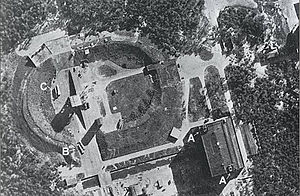Test Stand 7
| Test Stand VII | |
|---|---|
| German: Prüfstand VII | |
| Part of Army Research Center Peenemünde, Nazi Germany |
|
| Usedom island | |

23 June 1943 RAF reconnaissance photo of Test Stand VII
|
|

Diorama at Peenemünde Historical and Technical Information Centre
|
|
| Coordinates | 54°10′6″N 13°48′17″E / 54.16833°N 13.80472°E |
| Type | bunker |
| Height | 10 metres (33 ft) hohe Bóschung |
| Site information | |
| Open to the public |
Peenemünde Historical and Technical Information Centre |
| Condition | demolished |
| Site history | |
| Built | 1938 |
| Built by | HVP |
| In use | World War II |
| Materials | sand, concrete, brick, steel |
| Demolished | 1961 |
| Battles/wars | Operation Crossbow, Operation Hydra |
| Events | DERA rocket model club launches |
| Garrison information | |
| Past commanders |
Engineers in Charge: Fritz Schwarz (1943), Hartmut Kuechen (through May 1944), followed by Dieter Huzel, then Dr. Kurt H. Debus. |
|
|
Test Stand VII (German: Prüfstand VII, P-7) was the principal V-2 rocket testing facility at Peenemünde Airfield and was capable of static firing of rocket motors up to 200 tons thrust. Notable events at the site include the first successful V-2 launch on 3 October 1942, visits by German military leaders, and Allied reconnaissance overflights and bombing.
Two distinguishing features of P-7 were the 670-yard-long elliptical high-sloped sand wall and the wide concrete-lined trench (flame pit) with a large symmetrical water-cooled flame deflector of molybdenum-steel pipes. The concrete trench, nearly 25 feet (7.6 m) wide with 3 feet (0.91 m) concrete walls, sloped gradually away from each side of the flame deflector to a depth of 20 feet (6.1 m), rising again symmetrically toward the side of the arena. Beside the flame pit was a long underground room where 4 feet (1.2 m) diameter delivery pipes were housed to route cooling water at 120 gallon per second from three huge pumps in the pumphouse to the flame deflector in the pit.
While the elliptical sand wall was for blocking high sea winds and blown sand, concrete structures were integrated into the wall and under the ground to protect equipment and personnel from rocket explosions and enemy bombing (a sand-filled dummy warhead, called "the elephant", was normally used). A large gap in the wall allowed easy entry by vehicles (particularly railcars with propellants), and an open tunnel through the ellipse wall at the narrower southern end also allowed entry. Integrated into the ellipse wall next to the tunnel was a massive observation and measuring blockhouse containing the control center. The control center had a double door with a bulletproof glass window from which an observer maintained telephone communication with the Telemetering Building at a remote location from P-7. A receiver in a lighthouse near Koserow provided telemetry from rockets with the Wolman System for Doppler tracking. For rockets that used radio control for V-2 engine cutoff, the Brennschluss equipment included a transmitter on the bank of the Peene about 7.5 miles (12.1 km) from P-7 and the Doppler radar at Lubmin (a motorized Würzburg radar, the "rhinoceros").
...
Wikipedia
